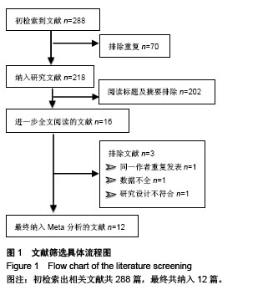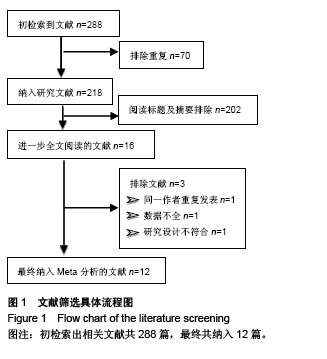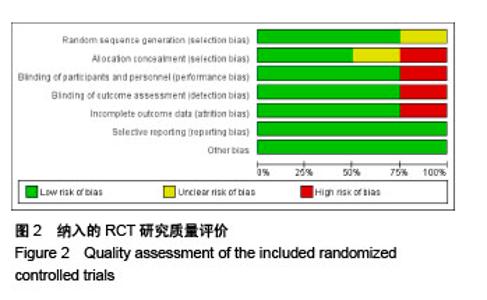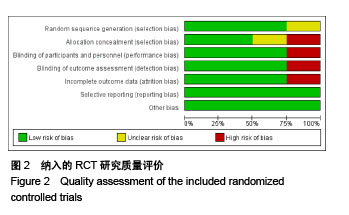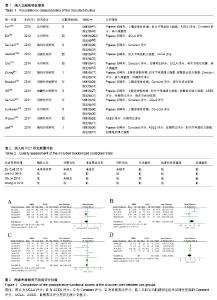Chinese Journal of Tissue Engineering Research ›› 2018, Vol. 22 ›› Issue (24): 3921-3929.doi: 10.3969/j.issn.2095-4344.0327
Previous Articles Next Articles
Curative efficacy of tenotomy versus tenodesis for long head of the biceps tendon lesions combined with rotator cuff repair: a Meta-analysis
Yi Gang1, 2, Yang Jing1, 2, Zhang Lei1, 2, Fu Shi-jie1, 2, Zhou Xin1, 2, Liu Gang1, 2, Guo Xiao-guang1, 2, Liu Yang1, 2, Qin Bo1, 2
- 1Department of Orthopedics, the Affiliated Hospital of Traditional Chinese Medicine of Southwest Medical University, Luzhou 646000, Sichuan Province, China; 2Academician Workstation in Luzhou, Luzhou 646000, Sichuan Province, China
-
Received:2018-05-14 -
Contact:Fu Shi-jie, Master, Professor, Chief physician, Master’s supervisor, Department of Orthopedics, the Affiliated Hospital of Traditional Chinese Medicine of Southwest Medical University, Luzhou 646000, Sichuan Province, China; Academician Workstation in Luzhou, Luzhou 646000, Sichuan Province, China -
About author:Yi Gang, Master candidate, Department of Orthopedics, the Affiliated Hospital of Traditional Chinese Medicine of Southwest Medical University, Luzhou 646000, Sichuan Province, China; Academician Workstation in Luzhou, Luzhou 646000, Sichuan Province, China -
Supported by:the Research Program of Education Department of Sichuan Province, No. 17ZB0472; the Academician Workstation Construction Project of Luzhou, No. 20180101
CLC Number:
Cite this article
Yi Gang1, 2, Yang Jing1, 2, Zhang Lei1, 2, Fu Shi-jie1, 2, Zhou Xin1, 2, Liu Gang1, 2, Guo Xiao-guang1, 2, Liu Yang1, 2, Qin Bo1, 2. Curative efficacy of tenotomy versus tenodesis for long head of the biceps tendon lesions combined with rotator cuff repair: a Meta-analysis[J]. Chinese Journal of Tissue Engineering Research, 2018, 22(24): 3921-3929.
share this article
| [1] Boileau P,Baqué F,Valerio L,et al.Isolated arthroscopic biceps tenotomy or tenodesis improves symptoms in patients with massive irreparable rotator cuff tears. J Bone Joint Surg Am. 2007;89(4):747-757.[2] Nassos JT.Arthroscopic rotator cuff repair with biceps tendon augmentatio. Am J Orthop (Belle Mead NJ).2009; 38(6):279-281.[3] Su WR, Budoff JE.The effect of posterosuperior rotator cuff tears and biceps loading on glenohumeral translation. Arthroscopy. 2010;26(5):578-586.[4] Elser F,Braun S,Dewing CB,et al.Anatomy, function, injuries, and treatment of the long head of the biceps brachii tendon. Arthroscopy. 2011;27(4):581-592.[5] Kennedy NI,Sanchez G,Mannava S,et al.Arthroscopic Rotator Cuff Repair With Mini-open Subpectoral Biceps Tenodesis. Arthrosc Tech. 2017;6(5):e1667-e1674.[6] Glait SA, Mahure S, Loomis CA, et al.Regional histologic differences in the long head of the biceps tendon following subpectoral biceps tenodesis in patients with rotator cuff tears and SLAP lesions. Knee Surg Sports Traumatol Arthrosc. 2018 Jan 23.[7] Ataoglu MB,Cetinkaya M,Ozer M,et al.The high frequency of superior labrum, biceps tendon, and superior rotator cuff pathologies in patients with subscapularis tears: A cohort study. J Orthop Sci. 2018;23(2):304-309.[8] Voss A,Cerciello S,DiVenere J,et al.Open subpectoral biceps tenodesis in patients over 65 does not result in an increased rate of complications. BMC Musculoskelet Disord. 2017;18(1): 430.[9] Desai SS, Mata HK.Long Head of Biceps Tendon Pathology and Results of Tenotomy in Full-Thickness Reparable Rotator Cuff Tear.Arthroscopy. 2017;33(11):1971-1976.[10] Fleck KE, Field LD. Consolidated Proximal Biceps Tenodesis and Subscapularis Repair. Arthrosc tech.2017;6(5): e1967-e1971. [11] Ciccotti MG.Editorial Commentary: The Long Head of the Biceps Brachii Tendon-The Shoulder Surgeon's Conundrum. Arthroscopy. 2017;33(11):1937-1939.[12] Frost A,Zafar MS,Maffulli N.Tenotomy versus tenodesisin the management of pathologic lesions of the tendon ofthe long head of the biceps brachii.Am J Sports Med.2009; 37: 828-833. [13] Nho SJ, Strauss EJ, Lenart BA, et al. Long head of the biceps tendinopathy: diagnosis and management. J Am Acad Orthop Surg. 2010;18(11):645-656. [14] De Carli A,Vadalà A,Zanzotto E,et al.Reparable rotator cuff tears with concomitant long-head biceps lesions: tenotomy or tenotomy/tenodesis?. Knee Surg Sports Traumatol Arthrosc. 2012;20(12):2553-2558.[15] Kerschbaum M,Maziak N,Scheuermann M.Arthroscopic tenodesis or tenotomy of the long head of the biceps tendon in preselected patients: Does it make a difference?. Der Orthopa?de. 2017;46(3): 215-221.[16] Ahmad CS,DiSipio C,Lester J,et al.Factors affecting dropped biceps deformity after tenotomy of the long head of the biceps tendon. Arthroscopy. 2007;23(5):537-541.[17] Klinger HM,Spahn G,Baums MH.Arthroscopic debridement of irreparable massive rotator cuff tears--a comparison of debridement alone and combined procedure with biceps tenotomy. Acta Chir Belg. 2005;105(3): 297-301.[18] Friedman JL,FitzPatrick JL,Rylander LS,et al.Biceps Tenotomy Versus Tenodesis in Active Patients Younger Than 55 Years: Is There a Difference in Strength and Outcomes?. Orthop J Sports Med. 2015;3(2):2325967115570848.. [19] Ribeiro FR,Ursolino APS,Ramos VFL,et al.Disorders of the long head of the biceps: tenotomy versus tenodesis. Rev Bras Ortop. 2017;52(3):291-297.[20] Gervasi E,Sebastiani E.No-holes transpectoral tenodesis technique vs tenotomy of the long head of the biceps brachii. Muscles Ligaments Tendons J. 2016;6(4):427-432. [21] Castricini R,Familiari F,De Gori M,et al.Tenodesis is not superior to tenotomy in the treatment of the long head of biceps tendon lesions. Knee Surg Sports Traumatol Arthrosc. 2018;26(1):169-175.[22] Park JY,Lee JH,Oh KS,et al.Bridge Tenodesis: A Secure Fixation Technique for Biceps Long Head Tendinopathy During Arthroscopic Rotator Cuff Repair Using a Suture-Bridge Technique. Arthrosc Tech. 2016;5(5):e1077-e1081.[23] Hsu AR,Ghodadra NS,Provencher MT,et al.Biceps tenotomy versus tenodesis: a review of clinical outcomes and biomechanical results. J Shoulder Elbow Surg. 2011;20(2):326-332.[24] Gombera MM,Kahlenberg CA,Nair R,et al.All-arthroscopic suprapectoral versus open subpectoral tenodesis of the long head of the biceps brachii. Am J Sports Med. 2015;43(5): 1077-1083.[25] Checchia SL,Doneux PS,Miyazaki AN,et al.Biceps tenodesis associated with arthroscopic repair of rotator cuff tears. J Shoulder Elbow Surg. 2005;14(2):138-144.[26] Frost A,Zafar MS.Tenotomy versus tenodesis in the management of pathologic lesions of the tendon of the long head of the biceps brachii. Am J Sports Med. 2009;37(4):828-833.[27] Meeks BD,Meeks NM,Froehle AW,et al.Patient Satisfaction After Biceps Tenotomy. Orthop J Sports Med. 2017; 5(5): 2325967117707737.[28] Delle Rose G,Borroni M,Silvestro A,et al.The long head of biceps as a source of pain in active population: tenotomy or tenodesis? A comparison of 2 case series with isolated lesions. Musculoskelet Surg. 2012;96 Suppl 1:S47-52.[29] Koh KH,Ahn JH,Kim SM.Treatment of biceps tendon lesions in the setting of rotator cuff tears: prospective cohort study of tenotomy versus tenodesis. Am J Sports Med. 2010;38(8): 1584-1590.[30] Zhang Q,Zhou J,Ge H,et al.Tenotomy or tenodesis for long head biceps lesions in shoulders with reparable rotator cuff tears: a prospective randomised trial. Knee Surg Sports Traumatol Arthrosc. 2015; 23(2): 464-469.[31] Cho NS,Cha SW.Funnel tenotomy versus intracuff tenodesis for lesions of the long head of the biceps tendon associated with rotator cuff tears. Am J Sports Med. 2014;42(5):1161-1168.[32] Franceschi F,Longo UG,Ruzzini L,et al.No advantages in repairing a type II superior labrum anterior and posterior (SLAP) lesion when associated with rotator cuff repair in patients over age 50: a randomized controlled trial. Am J Sports Med. 2008;36(2): 247-253.[33] Karlsson J.In Reparable Rotator Cuff Tears with Lesions of the Long Head of the Biceps Brachii Tendon, Tenotomy Did Not Differ from Tenodesis in Terms of Function or Pain.JB &JS.2017;99(4): 351.[34] Slenker NR,Lawson K,Ciccotti MG,et al.Biceps tenotomy versus tenodesis: clinical outcomes. Arthroscopy. 2012;28(4): 576-582.[35] Leroux T,Chahal J,Wasserstein D,et al.A Systematic Review and Meta-analysis Comparing Clinical Outcomes After Concurrent Rotator Cuff Repair and Long Head Biceps Tenodesis or Tenotomy. Sports Health. 2015; 7(4): 303-307.[36] Ge H,Zhang Q,Sun Y,et al.Tenotomy or tenodesis for the long head of biceps lesions in shoulders: a systematic review and meta-analysis. PloS one.2015;10(3): e0121286.[37] Shang X,Chen J.A meta-analysis comparing tenotomy and tenodesis for treating rotator cuff tears combined with long head of the biceps tendon lesions. PloS one.2017;12(10): e0185788.[38] Meraner D,Sternberg C,Vega J,et al.Arthroscopic tenodesis versus tenotomy of the long head of biceps tendon in simultaneous rotator cuff repair. Arch Orthop Trauma Surg. 2016;136(1): 101-106.[39] Biz C,Vinanti GB,Rossato A,et al.Prospective study of three surgical procedures for long head biceps tendinopathy associated with rotator cuff tears. Muscles Ligaments Tendons J.2012;2(2): 133-136.[40] Ikemoto RY, Pileggi PE, Murachovsky J, et al. tenotomy with or without tenodesis of the long head of the biceps using repair of the rotator cuff.Rev Bras Ortop.2015;47(6):736-740.[41] Kukkonen J,Rantakokko J,Virolainen P.The effect of biceps procedure on the outcome of rotator cuff reconstruction. ISRN Orthop. 2013 ;2013:840965. [42] Oh JH,Lee YH,Kim SH,et al.Comparison of Treatments for Superior Labrum-Biceps Complex Lesions With Concomitant Rotator Cuff Repair: A Prospective, Randomized, Comparative Analysis of Debridement, Biceps Tenotomy, and Biceps Tenodesis. Arthroscopy.2016; 32(6): 958-967.[43] Senturk I,Ozalay M,Akpinar S,et al.Clinical and isokinetic comparison between tenotomy and tenodesis in biceps pathologies. Acta Orthop Traumatol Turc. 2011;45(1):41-46.[44] Watson ST,Robbins CB,Bedi A,et al.Comparison of Outcomes 1 Year After Rotator Cuff Repair With and Without Concomitant Biceps Surgery.Arthroscopy.2017;33(11): 1928-1936.[45] Lee HJ,Jeong JY,Kim CK.Surgical treatment of lesions of the long head of the biceps brachii tendon with rotator cuff tear: a prospective randomized clinical trial comparing the clinical results of tenotomy and tenodesis. J Shoulder Elbow Surg.2016;25(7): 1107-1114.[46] Lee SH,Nam DJ,Kim SJ.Comparison of Clinical and Structural Outcomes by Subscapularis Tendon Status in Massive Rotator Cuff Tear. Am J Sports Med. 2017;45(11):2555-2562.[47] Chen CH,Hsu KY,Chen WJ.Incidence and severity of biceps long head tendon lesion in patients with complete rotator cuff tears. J Trauma. 2005;58(6):1189-1193.[48] Barber FA,Field LD.Biceps tendon and superior labrum injuries: decision making. Instr Course Lect. 2008; 57: 527-538.[49] Maynou C,Mehdi N,Cassagnaud X,et al.[Clinical results of arthroscopic tenotomy of the long head of the biceps brachii in full thickness tears of the rotator cuff without repair: 40 cases]. Rev Chir Orthop Reparatrice Appar Mot. 2005;91(4): 300-306.[50] Kelly AM,Drakos MC,Fealy S,et al.Arthroscopic release of the long head of the biceps tendon: functional outcome and clinical results. Am J Sports Med. 2005;33(2): 208-213.[51] Carpenter JE,Flanagan CL,Thomopoulos S,et al.The effects of overuse combined with intrinsic or extrinsic alterations in an animal model of rotator cuff tendinosis. Am J Sports Med. 1998; 26(6):801-807.[52] Gurnani N,van Deurzen DF,Janmaat VT.Tenotomy or tenodesis for pathology of the long head of the biceps brachii: a systematic review and meta-analysis. Knee Surg Sports Traumatol Arthrosc. 2016;24(12):3765-3771.[53] Scheibel M,Schröder RJ,Chen J.Arthroscopic soft tissue tenodesis versus bony fixation anchor tenodesis of the long head of the biceps tendon. Am J Sports Med. 2011;39(5):1046-1052.[54] Kukkonen J,Kauko T,Vahlberg T,et al.Investigating minimal clinically important difference for Constant score in patients undergoing rotator cuff surgery.J Shoulder Elbow Surg.2013; 22(12):1650-1655.[55] Moon SC,Cho NS.Analysis of "hidden lesions" of the extra-articular biceps after subpectoral biceps tenodesis: the subpectoral portion as the optimal tenodesis site.Am J Sports Med.2015;43(1): 63-68. |
| [1] | Chen Junming, Yue Chen, He Peilin, Zhang Juntao, Sun Moyuan, Liu Youwen. Hip arthroplasty versus proximal femoral nail antirotation for intertrochanteric fractures in older adults: a meta-analysis [J]. Chinese Journal of Tissue Engineering Research, 2021, 25(9): 1452-1457. |
| [2] | Chen Jinping, Li Kui, Chen Qian, Guo Haoran, Zhang Yingbo, Wei Peng. Meta-analysis of the efficacy and safety of tranexamic acid in open spinal surgery [J]. Chinese Journal of Tissue Engineering Research, 2021, 25(9): 1458-1464. |
| [3] | Hu Kai, Qiao Xiaohong, Zhang Yonghong, Wang Dong, Qin Sihe. Treatment of displaced intra-articular calcaneal fractures with cannulated screws and plates: a meta-analysis of 15 randomized controlled trials [J]. Chinese Journal of Tissue Engineering Research, 2021, 25(9): 1465-1470. |
| [4] | Huang Dengcheng, Wang Zhike, Cao Xuewei. Comparison of the short-term efficacy of extracorporeal shock wave therapy for middle-aged and elderly knee osteoarthritis: a meta-analysis [J]. Chinese Journal of Tissue Engineering Research, 2021, 25(9): 1471-1476. |
| [5] | Wang Yongsheng, Wu Yang, Li Yanchun. Effect of acute high-intensity exercise on appetite hormones in adults: a meta-analysis [J]. Chinese Journal of Tissue Engineering Research, 2021, 25(8): 1305-1312. |
| [6] | Kong Desheng, He Jingjing, Feng Baofeng, Guo Ruiyun, Asiamah Ernest Amponsah, Lü Fei, Zhang Shuhan, Zhang Xiaolin, Ma Jun, Cui Huixian. Efficacy of mesenchymal stem cells in the spinal cord injury of large animal models: a meta-analysis [J]. Chinese Journal of Tissue Engineering Research, 2021, 25(7): 1142-1148. |
| [7] | Zhang Lei, Ma Li, Fu Shijie, Zhou Xin, Yu Lin, Guo Xiaoguang. Arthroscopic treatment of greater tuberosity avulsion fractures with anterior shoulder dislocation using the double-row suture anchor technique [J]. Chinese Journal of Tissue Engineering Research, 2021, 25(6): 895-900. |
| [8] | Huang Dengcheng, Wang Zhike, Cao Xuewei. Intravenous, topical tranexamic acid alone or their combination in total knee arthroplasty: a meta-analysis of randomized controlled trials [J]. Chinese Journal of Tissue Engineering Research, 2021, 25(6): 948-956. |
| [9] | Li Yan, Wang Pei, Deng Donghuan, Yan Wei, Li Lei, Jiang Hongjiang. Electroacupuncture for pain control after total knee arthroplasty: a meta-analysis [J]. Chinese Journal of Tissue Engineering Research, 2021, 25(6): 957-963. |
| [10] | He Xiangzhong, Chen Haiyun, Liu Jun, Lü Yang, Pan Jianke, Yang Wenbin, He Jingwen, Huang Junhan. Platelet-rich plasma combined with microfracture versus microfracture in the treatment of knee cartilage lesions: a meta-analysis [J]. Chinese Journal of Tissue Engineering Research, 2021, 25(6): 964-969. |
| [11] | Hua Haotian, Zhao Wenyu, Zhang Lei, Bai Wenbo, Wang Xinwei. Meta-analysis of clinical efficacy and safety of antibiotic artificial bone in the treatment of chronic osteomyelitis [J]. Chinese Journal of Tissue Engineering Research, 2021, 25(6): 970-976. |
| [12] | Zhan Fangbiao, Cheng Jun, Zou Xinsen, Long Jie, Xie Lizhong, Deng Qianrong. Intraoperative intravenous application of tranexamic acid reduces perioperative bleeding in multilevel posterior spinal surgery: a meta-analysis [J]. Chinese Journal of Tissue Engineering Research, 2021, 25(6): 977-984. |
| [13] | Zhong Yuanming, Wan Tong, Zhong Xifeng, Wu Zhuotan, He Bingkun, Wu Sixian. Meta-analysis of the efficacy and safety of percutaneous curved vertebroplasty and unilateral pedicle approach percutaneous vertebroplasty in the treatment of osteoporotic vertebral compression fracture [J]. Chinese Journal of Tissue Engineering Research, 2021, 25(3): 456-462. |
| [14] | Li Yang, Zhang Mingyong. Meta-analysis of the effect of double Endobutton and clavicular hook plate on the treatment of acromioclavicular dislocation [J]. Chinese Journal of Tissue Engineering Research, 2021, 25(3): 463-470. |
| [15] | Li Yanle, Yue Xiaohua, Wang Pei, Nie Weizhi, Zhang Junwei, Tan Yonghai, Jiang Hongjiang. Intramedullary nail fixation versus plate fixation in the treatment of displaced midshaft clavicular fractures in adults: a meta-analysis [J]. Chinese Journal of Tissue Engineering Research, 2021, 25(3): 471-476. |
| Viewed | ||||||
|
Full text |
|
|||||
|
Abstract |
|
|||||
